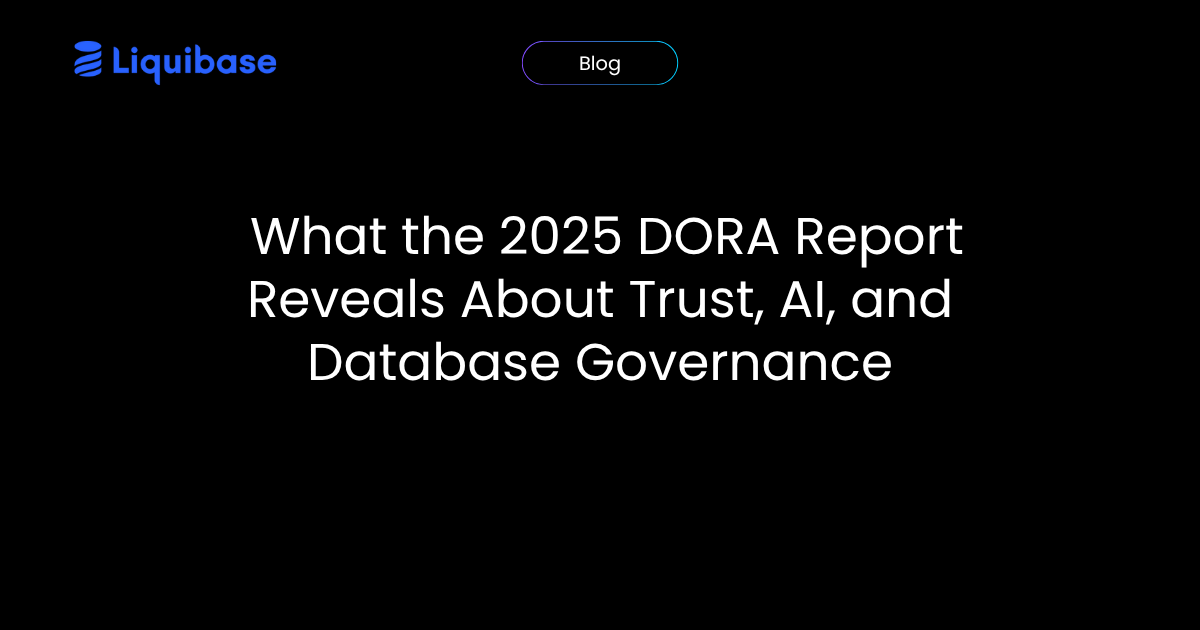Database change management best practices
July 3, 2024
See Liquibase in Action
Accelerate database changes, reduce failures, and enforce governance across your pipelines.

When it comes to the evolution of your database’s schema, data, and policies, how you manage change will have impacts throughout the software development lifecycle. Embracing an optimal approach to database change management (DCM) – and continuously monitoring and optimizing it for safety, efficiency, and innovation – means the very core of your data-driven business gets the care, attention, and protection it needs to deliver value.
But what would an optimal approach to database change management look like?
No manual review processes. Embracing automation. Maximize collaboration and transparency to build trust and support efficiency. With the right tracking in place, the best approach to database change management would also enable end-to-end observability for measuring pipeline efficiency, capturing detailed activity reports, and enhancing security and compliance.
In this article, you’ll learn best practices for optimizing for faster delivery, higher quality, and better visibility.
What is database change management?
Database change management involves developing, reviewing, tracking, and deploying database updates efficiently and securely. Treating database changes as code, database change management integrates with DevOps principles and CI/CD pipelines to ensure database schemas align with application requirements – without delaying or disrupting the rest of the pipeline.
Change management automation streamlines this process, enabling immediate feedback and error detection, as well as smaller, more frequent deployments that keep pace and remain agile.
Considerations for application development pipelines
Database change management ensures changes are efficiently managed, tracked, and deployed, maintaining system availability, data integrity, and database performance.
In application pipelines, the biggest issue we see is the time it takes to bring a database change through proper review. As more application updates require changes to database schema, delays become bottlenecks. Database change management requires not only better alignment with development workflows, but also ways to process and review changes that move as fast, yet reliably, as the rest of the application pipeline (think CI/CD.)
Considerations for data pipelines
By managing schema changes, data updates, and new integrations, database change management prevents disruptions in data quality and access. It ensures the integrity and availability of data used by data scientists, analysts, and business intelligence (BI) teams. Meanwhile, for data engineers building AI/ML platforms, this change management is also vital for maintaining data consistency and context around raw or unstructured data from many sources, ensuring robust and reliable model training and deployment.
With systems for governing and tracking database changes, teams can more easily maintain audit trails and ensure compliance and data security. This reliability is crucial for delivering accurate analytics and reporting, supporting better decision-making processes, and seamlessly integrating new data sources.
To learn more about change management for DataOps, check out Data pipeline change management: Solving challenges with automation.
Database change management best practices
Tthe right way to manage database changes is to adopt methodologies and processes that already work – namely, DevOps and CI/CD principles adapted from application development. Databases, however, have state – they exist in a certain way at a certain time – and so making and undoing changes, or moving backward and forward, isn’t quite the same.
Strategic approaches to database change management are sometimes slow to happen for this reason , but with the right approach, culture, and technology, you can bring DevOps to the database, too.
Document the process
The database change management process needs to be repeatable, consistent, and standardized. Without documentation of the process, stakeholders, and strategies, the team has no baseline on which to improve upon. This also feeds into training that keeps teams in line with vetted processes and ensures everyone understands their roles and responsibilities, which leads to smoother coordination and faster issue resolution.
Documentation extends to each individual change pushed through the pipeline. Detailed records of all database changes creates a traceable and auditable trail, essential for compliance with regulatory requirements and troubleshooting future issues. Including documentation of dependencies within the database and between the database and applications is also crucial to prevent cascading failures.
By documenting the process thoroughly, teams can continuously optimize, refining methodologies to improve overall efficiency and effectiveness. Process documentation also comes into play at the stage of automation implementation, when workflows can be mapped over and into tools that take the burden off humans while improving outcomes.
Embrace the migration-based approach
One of DORA's leading recommendations is to only use state-based changes in specific situations and defer instead to the migration-based approach. Migration-based changes involve explicitly defining and managing each change as individual scripts, which supports version control, auditing, and easier rollbacks.
State-based changes might seem like a simple and straightforward route, but actually presents too many deal-breaking questions to consider relying on:
- Which versions of the database are to be compared?
- How is that comparison being made?
- Have changes unknowingly been made to either state?
- Are your teammates comparing the same states?
A state-based approach also hinders flexibility. Because all changes are grouped together, you can’t easily break out changes into subsets if only part of a change request needs attention. This also means teams lose the ability to embrace small, incremental changes, which is fundamental in DevOps principles.
The migration-based approach can be even better aligned with DevOps culture and most successfully integrated into CI/CD pipelines when it’s taken a step further into an artifact-based approach. This method packages small, iterative changes (ChangeSets) into version-controlled artifacts called Changelogs. These Changelogs explicitly define the order and details of each change, allowing for precise tracking, testing, and deployment, while enabling better collaboration and flexibility among teams.
Learn more about why Liquibase embraces the artifact-based migration approach for more efficient, flexible, and collaborative change management.
Use version control
Version control is a foundational DeOps concept and essential for managing database changes efficiently and securely. By committing all changes to a version control system, teams can track modifications, ensuring a clear history for troubleshooting and audits that promotes consistency, reduces errors, and enhances pipeline efficiency.
Database version control supports collaborative development, integrates seamlessly with CI/CD pipelines, and allows for easier rollbacks. Incorporating version control ensures precise tracking, testing, and deployment of database changes.
Version control tends to be one of an organization’s first applications of change management automation.
Automate workflows
Automation can offer major gains in consistency and quality while freeing up valuable human resources to focus on more value-driving initiatives. Automating database change management workflows transforms slow, manual processes into efficient, self-service deployments.
Workflow automation can integrate version control, tracking, configurable CI/CD, and drift detection across both application and data pipelines. This user-centric approach allows developers to push their own changes, reduces the manual workload for DBAs, and enables DevOps teams to measure faster processes with fewer failed deployments.
Automation significantly reduces the risk of errors that manual processes are prone to, minimizing potential downtime, data loss, or performance issues. By executing changes through predefined scripts and workflows, automation ensures consistency and accuracy, thereby enhancing reliability. This approach also provides scalability and flexibility, handling complex database environments with multiple instances and configurations seamlessly.
Make it user-friendly
User-centric database change management means enacting processes, tooling, and automation that turns a tedious, manual, toilsome process into a quick, easy, painless one. That includes self-service database deployments that are seamlessly integrated into CI/CD pipelines. It’s also a matter of tracking and measuring – database observability enables ongoing process optimization for the benefit of user-friendliness by way of reducing errors and solving inefficiencies.
Govern code quality & safety
Ensuring the quality and safety of database code involves rigorous testing and review processes built into the automated pipeline. These checks include syntax validation, performance analysis, and security vulnerability assessments, all aimed at shifting left – identifying potential errors well before deployment. A systematic, customizable, tech-enabled approach to code quality helps prevent problems from affecting downstream environments
Maintaining code quality is crucial for data integrity, ensuring that applications relying on databases function without errors or inconsistencies. By catching errors early in the development lifecycle, teams can minimize deployment failures and reduce downtime. Additionally, code quality checks can identify inefficient queries, indexing issues, and other performance bottlenecks, enhancing overall database performance. Implementing these practices not only secures the database environment but also supports reliable and efficient operations across the entire data pipeline.
Enforce policies and best practices
Quality and safety are critical, but they aren’t the only elements of database change code to review and control. Organizational code standards, workflow policies, and best practices in database management, DevOps, and CI/CD should also be part of the optimal database change management workflow.
The downstream impacts of changes that violate these practices and policies might not tank system availability or expose sensitive data, but they can be just as problematic to teams, workflows, applications, and the business itself. After all, for a practice like business intelligence to be fruitful and reliable, teams need to be confident that data is entered correctly and evolved in line with established processes. Automating these policy enforcements minimizes the risks and further elevates overall data quality.
Enable easy rollbacks
Rollback capability is a critical safety net, ensuring teams can quickly revert to a previous stable state if an error or issue arises from changes. Maintaining robust rollback processes helps organizations minimize the impact of failed changes, creating system stability and user trust.
Automated and Targeted Rollbacks mitigate risk by minimizing operational and user experience impacts, ensuring business continuity by restoring database functionality and minimizing disruptions. By enabling easy rollbacks, teams can maintain stability while fostering a culture of continuous improvement and rapid iteration.
Empower immediate & continuous feedback
Immediate feedback on database changes sent for review means developers can quickly experiment, iterate, and improve their proposed changes before pushing them through the pipeline. This capability validates the effectiveness of changes and detects issues early, enabling prompt corrective action. Liquibase enables immediate database change feedback through customizable Quality Checks.
Continuous workflow feedback – which feeds into continuous optimization efforts – can come from the analysis of cumulative check results , but more fully from tracking metadata associated with changes as they move through the pipeline. This feedback helps teams to learn and improve from each change cycle to refine processes, tools, and approaches based on real-world experiences and outcomes.
Of course, that means teams need to have granular change management tracking in place.
Track everything – monitor what matters
Proper traceability, auditability, and observability hinges on how precise, specific, and contextualized the change tracking data can be. It’s important to capture the “who, what, where, when, why, and how” of every change at an atomic level, breaking complex changes down into their iterative components, even.
Tracking everything doesn’t necessarily mean every data point gets analyzed – but it’s there if needed now or in the future. When it comes to monitoring and observing to prevent problems and target improvements, change operation reporting can provide critical context on activities while pipeline analytics can paint a picture of workflow performance and effectiveness.
Extend DevOps to the database with Liquibase
The takeaway? Database teams need to embrace DevOps thinking to maximize quality, reliability, and speed.
Learn more about how Liquibase brings DevOps to the database with automation, governance, and observability for an optimal database change management approach.
Database change management FAQs
How does the migration-based approach improve database change management?
The migration-based approach defines changes as individual scripts rather than comparing database states. This method provides better version control and clear audit trails of all database modifications. It enables teams to break complex changes into manageable subsets that can be reviewed independently.
By packaging changes into version-controlled artifacts called ChangeLogs, teams can track, test, and deploy database updates with greater precision and flexibility.
What are the key benefits of automating database change management workflows?
Automation transforms slow manual processes into efficient self-service deployments with fewer errors. It significantly reduces the risk of downtime, data loss, and performance issues common in manual processes.
Automated workflows free up valuable DBA resources to focus on more strategic initiatives. According to DORA, organizations should aim for 100% of database changes to be made through fully automated processes.
How can teams ensure code quality and safety in database changes?
A systematic, customizable approach helps identify potential errors before they reach production environments. Teams should implement automated testing including…
- Syntax validation
- Performance analysis
- Security vulnerability assessments.
Early detection of issues minimizes deployment failures and reduces downtime across the pipeline. Quality checks should also identify inefficient queries and indexing issues that could affect database performance.
Why are tracking and observability important in database change management?
Comprehensive tracking captures the who, what, where, when, why, and how of every database change. This granular data provides necessary context for troubleshooting issues and meeting compliance requirements. Pipeline analytics help teams measure workflow performance and identify areas for improvement.
With proper observability, teams can prevent problems before they occur and continuously optimize their database change management processes.
What role does rollback capability play in effective database change management?
Rollback capability serves as a critical safety net when changes cause unforeseen issues in production. Well-designed rollback processes help minimize the impact of failed changes by quickly restoring previous stable states.
Automated and targeted rollbacks maintain business continuity by minimizing disruptions to operations. This capability encourages innovation by giving teams confidence to implement changes knowing they can be safely reversed if needed.




.png)
.png)

.png)





